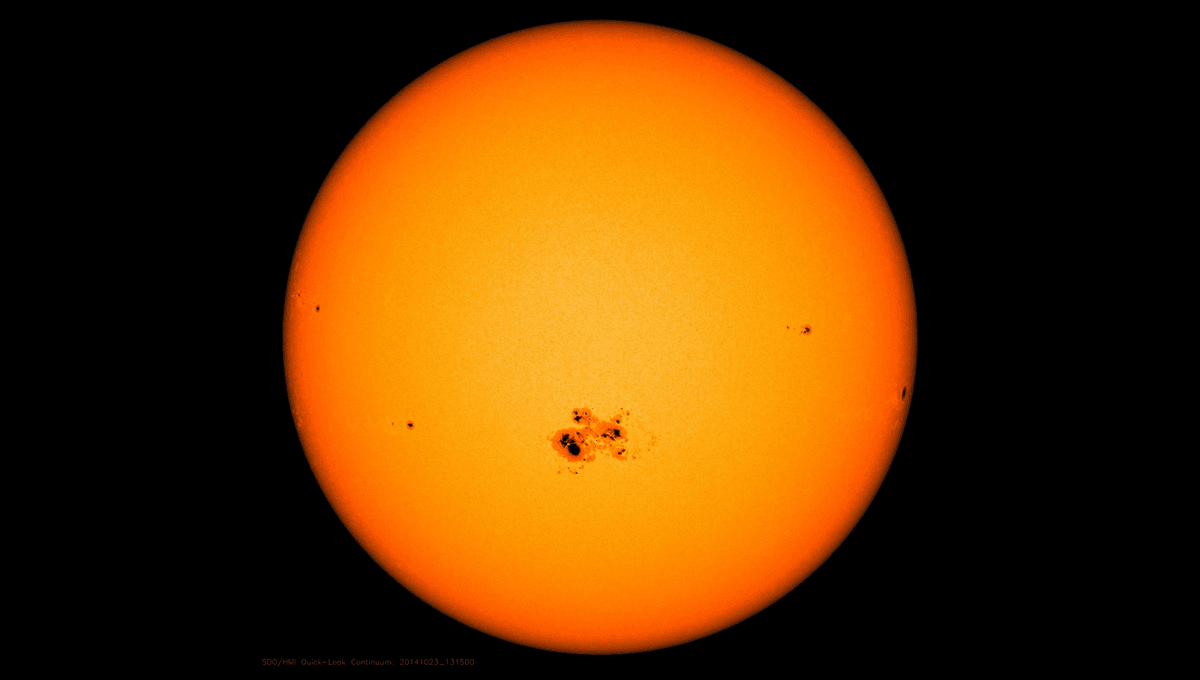
The length of the primary cycle for solar activity has been attributed to the combined gravitational effects of Venus, Earth, and Jupiter.
The spectacular auroral show of May 10 has made millions of people familiar with solar activity who had not been aware of it before. Inevitably, many want to know why sunspots and coronal mass ejections occur on an 11-year cycle. Most astronomers can only shrug, but a small minority think they have an answer, and some of them have just provided more detail for their case.
Millions of people have, on first learning that the Sun’s activity peaks every 11 years, noticed that this is quite similar to the length of Jupiter’s orbit (11.86 years). Might there be a connection? Generally, this has been a passing thought, with no explanation of how the two might be linked. However, researchers at the Helmholtz-Zentrum Dresden-Rossendorf (HZDR) think tides raised by the planets within the Sun could be responsible.
Known as the “planetary hypothesis”, the idea runs that tides produced by planets’ gravity cause vortexes of current within the Sun known as Rossby waves, which in turn affect solar magnetism. The whole thing sounds a bit like astrology, however, and most astronomers have treated it with great suspicion.
The Moon, Sun, and (to a minor extent) the planets produce tides on Earth. The planets also raise tides on the Sun, varying in size depending on their mass and distance. After all, Jupiter has enough gravitational influence that it and the Sun orbit a combined center of gravity outside the Sun’s surface.
Whether this matters in any noticeable way is more contentious.
The 11-year pattern in the Sun’s activity that is now nearing a peak is known as the Schwabe cycle after 19th-century astronomer Heinrich Schwabe. However, this is only one of a number of observed solar cycles, including both much shorter and much longer ones, which have proven equally hard to explain. We know other stars undergo similar cycles, although in most cases our data is quite recent.
Solar maxima are not like a metronome – thus the debate as to whether this one is happening early – but on average they are 11.07 years apart. The significance of the 11.07-year period, as opposed to 11.86 years for Jupiter to make an orbit, is not immediately obvious, but Dr Frank Stefani of HZDR argues it represents a beat created by alignments of Jupiter, Venus, and Earth. Stefani has long thought this is not a coincidence, and now presents what he claims is a mechanism.
“You can think of it like a gigantic dynamo,” Stefani said in a statement. “While this solar dynamo generates an approximately 11-year activity cycle in its own right, we think the planets’ influence then intervenes in the workings of this dynamo, repeatedly giving it a little push and thus forcing the unusually stable 11.07-year rhythm on the Sun.”
“We have now found the underlying physical mechanism. We know how much energy is required to synchronize the dynamo, and we know that this energy can be transferred to the Sun by so-called Rossby waves. The great thing is that we can now not only explain the Schwabe cycle and longer solar cycles but also the shorter Rieger cycles that we hadn’t even considered previously,” Stefani added.
The authors conclude that when two of Venus, Earth and Jupiter line up it creates the sort of effect seen in the “spring tide” on Earth when the Sun and Moon’s pull combines to create an enhanced effect. This activates Rossby waves comparable to high and low pressure systems in Earth’s atmosphere.
These alignments occur on 118, 193, and 299-day cycles, matching the shorter Rieger cycles observed in solar activity. All three planets align more rarely, but when they do so the effect is larger, which is why the Schwabe cycle is so much more obvious than the shorter ones. Other planets have similar but smaller effects; Stefani and co-authors claim to be able to spot lower peaks in activity caused by alignments of Mercury and Saturn with the three most influential planets.
Stefani also predicts these planetary effects should create a 193-year cycle, but we haven’t been watching the Sun long enough to confirm that.
Even Stefani admits his work is not conclusive. “We’ll probably only be 100 percent certain when we have more data,” he said. Other astronomers may be considerably harder to convince. The movements of the planets spit out a lot of numbers; stare at them long enough and it’s easy to become convinced you’ve found a pattern that matches the messy data from the Sun.
We haven’t been tracking sunspots that long, after all, although efforts have been made to estimate previous solar activity based on carbon-14 concentrations in tree rings and historical reports of auroras. The further we go back in time, the shakier the data set, and the less clear it is whether the 11-year cycle of solar activity is permanent, as Stefani’s claims require.
The authors speculate about much longer cycles, such as those that take into account alignments of the four gas giants. However, perhaps the only way claims like this will become truly convincing is if matches can be found between other stars’ cycles and their own planetary systems.
The study is open access in Solar Physics.
Source Link: The Sun’s Cycles Might Be Driven By The Influence Of The Planets, Study Claims